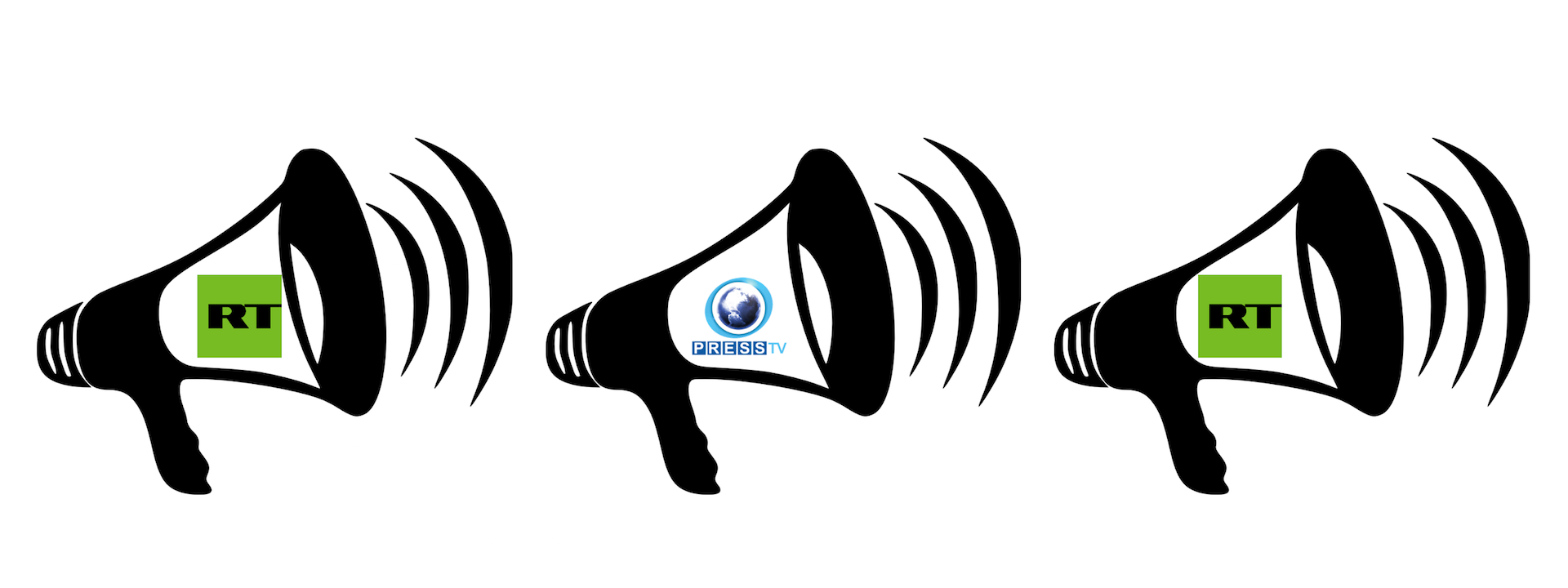Too Close For Comfort: RT and Press TV
How Iranian and Russian state-funded media outlets amplify each other
Too Close For Comfort: RT and Press TV

How Iranian and Russian state-funded media outlets amplify each other

In September 2017, Iranian and Russian media delegations met in Moscow to discuss cooperation and how to “counter the spread of false reports against Iran and Russia in the Western media.” The meeting was held at the Iranian embassy in Moscow and attended by Russia’s state-funded outlet ITAR-TASS, Russia 24, and Iran’s state-funded outlet IRNA.
Veronika Krasheninnikova— adviser to the Director-General of “Russia Today”, which is the holding company of RT, Sputnik, and RIA — attended the event and lamented:
The biased approach of the Western media in covering the events in Iran and Russia and the spread of false messages that do not resemble reality.
Krasheninnikova is also a member of the Supreme Council of the Putin-affiliated United Russia political party, and Director-General of the Institute for Foreign Policy Studies and Initiatives in Russia think tank.
Amid the growing cooperation between Iranian and Russian state-sponsored media, namely RT and Press TV, some target audiences highly correlate.
Commentators
Eight out of eighteen of RT’s Op-Edge contributors are frequent commentators on Iran’s Press TV. For example, Martin Jay, a British journalist and RT Op-Edge writer, was interviewed by Press TV four times in the last three months. That did not come close to Catherine Shakdam’s nine appearances on Press TV in the same period.
Annie Machon, another RT writer, has been interviewed by Press TV on several occasions. Neil Clark and Finian Cunningham’s bios on RT reference their work for Press TV. John Pilger appeared on Press TV’s “Food For Thought” most recently in September to discuss the Palestinian issue. Similarly, RT’s Pepe Escobar has contributed to Press TV on several occasions, and RT’s Dan Glazebrook was last interviewed by Press TV in June 2017.
Biases
Both RT and Press TV share similar narratives in their reporting, particularly a strong anti-NATO stance and support for the regime of Bashar al-Assad in Syria. The narratives are a direct representation of Russian and Iranian foreign policy, which overlaps on numerous issues in the Middle East and Europe.
On November 10, RT and Press TV published articles about NATO’s “expansion eastward”. Press TV headlines included:
NATO training for nuclear arms near Russian borders: Defense minister
RT’s headline on the same topic at the same time was:
A similar pattern can be observed in RT and Press TV’s coverage of Syria. Between November 14 and November 16, RT and Press TV published several articles on the legality of foreign countries’ intervention in Syria. A Press TV headline read:
Russia foreign minister says US intervention in Syria illegal
RT put a different spin on their story with headlines that read:
Another interesting point of overlap is Press TV’s use of “Russophobia” in their reporting. “Russophobia” is a common trope in the Kremlin media, which refers to what the Kremlin perceives to be an anti-Russian sentiment. The term is often weaponized against countries that the Kremlin views as antagonistic. The term is very popular in Kremlin-funded media but rarely used in the same context outside of the pro-Kremlin media echo chamber.
Press TV wrote several articles referring to Russophobia in the Baltics, the United States, and the United Kingdom.

Conspiracy Theories
RT and Press TV also appear to propagate the same conspiracy theories. A telling example was Press TV’s coverage of the downing of Malaysian Airlines Flight 17 (MH17).


Press TV published articles alleging that the Western media was “misrepresenting” the neutral investigation into MH17 led by the Dutch Safety Board, which concluded the plane was downed by a Russian-made Buk missile. The Iranian reporting deferred suspicion that Russian-led separatists with access to Russian-made munitions shot down the commercial aircraft, and went on to suggest the plane was shot down by the United States or Ukraine.
The same narrative was prevalent on Kremlin-funded RT, which published articles consistently denying Russia’s involvement and accused Ukraine and the United States.

Online Links
RT and Press TV online links remain pervasive. RT is the third most popular referrer to Press TV’s online content. Data from Alexa.com shows that 3.6 percent of visitors to Press TV’s website arrived directly from RT’s website. This indicates a significant presence of backlinks to Press TV on RT’s website.

Alexa.com’s Audience Overlap Tool, which visualizes sites that have similar audiences, shows that Press TV attracts the same audience as several well-known pro-Kremlin sites, including VeteransToday, Russia Insider, The Russophile, South Front, The Duran, and Kremlin state-funded outlet TASS.

With the same commentators,content, narrative, and reporting, this correlation comes as no surprise.
Conclusion
The in-person meeting and content connections between Kremlin-funded RT and the Iranian government-funded Press TV reveal the depth of cooperation between Russian and Iranian authorities in what they call “countering the spread of false reports” in Western media. This evidence suggests the two states are — at least — aligned in an effort influence Western societies with biased reporting based on the overall foreign policy goals of their sponsor nations.
Follow along for more in-depth analysis from our #DigitalSherlocks.

